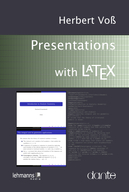
The early period of LaTeX-based presentations may be called a Gothic era. The lack of versatile building materials (even color was not so easy to achieve in those times) led to relatively pristine design with few or no visual effects.
This does not mean that all slides created with the SliTeX, seminar or foils classes were necessarily beautiful. Even among Gothic buildings one can find both masterpieces and ugly monsters. (By the way, the designation “Gothic” itself was originally a pejorative: Renaissance architects derisively stated that only uncouth Barbarians like Goths could make medieval buildings.) However, these slides were invariably simple. Presentations were just documents designed for a specific aspect ratio (usually 4:3) with large fonts (usually sans serif) and logos, often repeated on each page.
Meanwhile the purveyors of commercial programs—the ubiquitous PowerPoint being the pack leader—promoted a very different presentation style, with optical effects, complex page transitions and sophisticated overlays. At some point classical LaTeX presentations started to appear rather quaint. There was a distinct demand for a more “modern” presentation alternative.
The early efforts in this direction tried to copy PowerPoint’s approach and effects. Even their names, such as texpower or powerdot, sometimes suggested the connection. However, at some point it became clear that TeX, being a programming language, can give one almost infinite possibilities, far beyond those provided by non-extensible, end-user-oriented programs. These possibilities are especially evident in such packages as the current version of powerdot and the snazzy beamer. Here a user can, for example, typeset a mathematical formula having different terms highlighted and explained on different overlays, animate a sequence of frames, etc.—not even mentioning such common tasks as inserting a movie, or creating complex page transitions. Of course these possibilities give a user plenty of rope to hang himself, overloading the presentation visuals in a way detrimental to the presentation content. But in the hands of a good designer with taste and experience they may improve the result. Thus these packages opened the Baroque period of TeX-based presentations, with its indulgence and richness—and its tendency to over-emphasize effects.
One of the results of this development is the complexity of the interface for the modern presentation packages. The cheat sheet of foils commands can be put on a card-sized piece of paper, while the command texdoc beamer opens a 245-page document. While the packages have comprehensive manuals, for many people reading such a tome is a formidable task. Such users might prefer books written by somebody on the side of the user rather than the author. Thus books like the present one have a wide audience and an important task to perform.
Herbert Voß describes two packages: powerdot, based on PSTricks, and beamer, based on PGF (and initially written by Till Tantau of TikZ/PGF fame). It opens with a short chapter of obligatory advice about slide layout. Most of the material here is more or less known—and some, like the (in)famous one about no more than ten lines per slide would cause protests from the fans of Edward Tufte’s designs.
The strength of the book is in the very well-written chapters about powerdot and beamer. The explanation here follows the logic of developing a presentation. This makes the book much easier to read. The level of description is detailed, but the overall discussion is not lost in the details, and the reader is always aware of the general plan. The explanation of each package follows more or less the same path: Voß does not try to make two completely different presentation sequences, but neither does he blindly follow the parallel structures when the material does not justify this.
The book has many color illustrations including the comparison tables of slides using different motifs provided by the package authors. This should prove very useful for those lost in the hundreds of different combinations of beamer “outer themes”, “inner themes”, “font themes” and color schemes.
Besides “themes”, both powerdot and beamer provide extensive means to customize the output. However, it seems that many users feel intimidated by this richness. Many presentations at physics meetings look like identical twins: the authors just take the default template. Unfortunately the same is often true for TUG meetings, where death by PowerPoint becomes death by beamer. Herbert Voß devotes two detailed chapters to customization of powerdot and beamer respectively. The chapters are well written and will hopefully help the users to make their presentations more original. On the other hand, I dread the day when I see the first LaTeX-produced slides typeset in Comic Sans (unfortunately the fontspec package makes this task too easy, as shown).
There are two bonus chapters in the book. The first one is a concise explanation of color manipulation in LaTeX. Of course the xcolor package has an extensive manual, but Herbert’s text is much shorter and easier to read, keeping the most used features and omitting the more advanced and exotic ones. The second one, with the slightly misleading title Questions and Answers, is devoted to various odds and ends related to the packages and programs used in the book, and contains several useful hints as well as workarounds for some known bugs.
The book was originally published in German. The translation is good, and the couple of remaining examples of German syntax are rather cute; they do not disturb the reading.
The co-publishers, as with all of Voß’s recent books, are the German-speaking TeX users group DANTE, and Lehmanns Media. As is fitting for a TeX group-sponsored book, the typesetting is very good. In fact, this is the first of Herbert’s books I’ve read where his name on the cover is spelled as “Voß” rather than “Voss”. The fonts selected for the book, Linux Libertine, Lucida Sans and Bera Mono, are a good match.
This is a useful book which should be of interest to the wide audience of people preparing presentations with TeX.